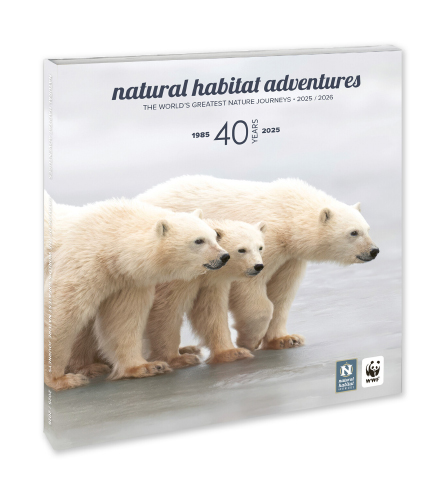Nat Hab’s mission is Conservation through Exploration: protecting our planet by inspiring travelers, supporting local communities and boldly influencing the entire travel industry. What began as a fledgling one-man operation has become a world leader in conservation travel. We owe our success to our diverse team of office and field staff, Expedition Leaders and guests.
We also owe gratitude to the intrepid explorers and conservationists of the past who paved the way for our global journeys. These individuals were pioneers in their fields, taking risks and overcoming adversity to discover new lands, protect wildlife and preserve cultural heritage. From the first Black man to reach the North Pole to the first woman to lead an Arctic expedition, these adventurers blazed a trail so that travelers today can experience the same awe-inspiring natural beauty for generations to come.
At our properties like Base Camp Greenland and Alaska Bear Camp, we honor our humble beginnings by proudly displaying the names of those who have helped us navigate the land we traverse.
Get to know some of the women we celebrate and get inspired by all they’ve accomplished!

© Court Whelan
Alaska Bear Camp
Follow in the footsteps of Alaskan frontierswomen and conservationists to experience an unparalleled immersion in pristine brown bear habitat from our fly-in camp in Lake Clark National Park. Built on the site of a historic homestead on the ancestral lands of the Dena’ina people, Alaska Bear Camp occupies a private inholding surrounded by 4 million acres of protected wilderness.
A nameplate graces the door of each one of our deluxe tent cabins. There’s one dedicated to pilot Celia Hunter, who protected the Yukon River from the Rampart Dam; Margaret Murie, the “Grandmother of the Conservation Movement”; and Ada Blackjack, the sole survivor of the Wrangel Island Expedition.
Read on to discover Alaska Bear Camp’s other honorees!

Rozie Bressler
Born to Russian immigrant parents in Brooklyn, Rosalind “Rozie” Bressler spent her childhood reading international mysteries featuring the far-off lands she yearned to visit one day. As a 16-year-old student at Smith College, Rozie spent hours in the library, burning through Fodor’s guidebooks. In the mid-1960s, Rozie relinquished her teaching career to raise her unruly sons, Ken and Nat Hab Founder Ben.

Rozie mentally escaped some of their shenanigans by reading Europe on $5 a Day and dreaming of exotic trips. When the boys got bored, Rozie shuffled them outside to explore the wooded gulley outside their New Jersey home.
In the 1960s, Rozie and her husband, Marty, spent weekends marching in Washington, protesting the Vietnam War and championing civil rights. In her pursuit of gender and race equality, Rozie became an attorney.
Between her League of Women Voters meetings and her role as Corporation Councilwoman for the city of Newark, Rozie led her family on cross-country road trips and international escapades. She brought them from museum to museum and park to park to satiate her love of history, nature and culture. Rozie collected travel experiences as others collected souvenirs, and she passed this passion for exploration on to her sons.
In the late 1980s, Rozie developed a brain tumor, which hindered her eyesight, so she left her job and joined Ben’s fledgling travel company, performing bookkeeping duties and “organizing the mayhem,” as Ben likes to say. Together, they visited the Galapagos Islands, Africa, the Arctic and the Yukon.
Brilliant, kind and unyielding in her pursuit of justice, Rozie influenced the creation of Natural Habitat Adventures and inspired our women-only adventures program, Women’s Journeys.
Christine Sisco
Christine Sisco was Nat Hab’s very first employee. She was working as a travel agent in New Jersey when she responded to a “Help Wanted” advertisement by Founder and President Ben Bressler. When Ben decided to relocate his company to the foot of the Rocky Mountains in Boulder, Colorado, Christine came too. She invited her husband on various early Nat Hab trips and enthusiastically shared photos and stories of their adventures with their children. Soon enough, the kids were tagging along to the Bahamas, Hawaii, Costa Rica, the Grand Canyon and everywhere in between.

Guided by an independent spirit, Christine always paved her own path and encouraged others to do the same. Her lust for life created some incredible travel memories, like when she flipped her kayak in Africa’s Zambezi River, followed her husband through an underground tunnel to watch elephants drink from a waterhole, and cruised around the Galapagos Islands with Ben and his parents.
Christine’s legacy perseveres with the help of her daughter Katrina, who followed in her mother’s footsteps and moved West to work for Nat Hab. As a member of the Alaska Operations team, Katrina looks after trip details, ensuring a gratifying adventure for guests. Katrina has visited more than 20 countries, including Canada with Nat Hab on a Churchill polar bear expedition, Brazil’s Pantanal and Tanzania to see the Great Migration. Christine passed in 2014, but her memory lives on through family and friends who admired her adventurous, vivacious, eclectic and selfless nature.
Margaret E. Murie
Endearingly referred to as “Mardy,” Margaret E. Murie, hailed as the “Grandmother of the Conservation Movement,” died peacefully on October 19, 2003, at 101, leaving an inspiring legacy in her wake.
In 1924, she became the first woman to graduate from the University of Alaska. After she married biologist Olaus Murie, the couple embarked on decades of scientific explorations from a 500-mile caribou research expedition by dogsled to a river journey with their infant son strapped to their canoe.

Mardy and Olaus Murie
After traveling in the Brooks Range above the Arctic Circle in the summer of 1956, Mardy and Olaus campaigned to make the area a wildlife reserve. Four years later, President Dwight D. Eisenhower designated 8 million acres as the Arctic National Wildlife Refuge; President Jimmy Carter more than doubled the protected area in 1980.
Mardy continued her advocacy work after her husband died in 1963. She returned to Alaska to survey potential wilderness areas for the National Park Service and worked on the Alaska National Interest Lands Conservation Act that President Carter signed in 1980. That legislation set aside more than 100 million acres of land in Alaska and upgraded Lake Clark National Monument to National Park status.
In her congressional testimony about the Alaska Lands Act, Mardy passionately relayed:
“I am testifying as an emotional woman, and I would like to ask you, gentlemen, what’s wrong with emotion? Beauty is a resource in and of itself. Alaska must be allowed to be Alaska; that is her greatest economy. I hope the United States of America is not so rich that she can afford to let these wildernesses pass by or so poor she cannot afford to keep them.”
Ada Delutuk Blackjack
Ada Delutuk Blackjack was born in 1898 in the Iñupiat village of Spruce Creek, in what was then known as the District of Alaska. She was raised in a Methodist missionary school, where she learned to read, write, cook and sew. At 16, she married Jack Blackjack and gave birth to three children. Only her son Bennett survived past infancy. However, he suffered from chronic tuberculosis. Jack abused Ada throughout their marriage, and after five years, he abandoned her.
After Jack left, Ada walked more than 40 miles from Spruce Creek to Nome, carrying her ailing son most of the way. She placed him in an orphanage and sought employment as a seamstress to make enough money to care for him again one day.

The Wrangel Island expedition party. Front row left to right: Allan Crawford, Ada Blackjack, Milton Galle and Victoria (the kitten born on the ship). Back row left to right: Fred Maurer and Lorne Knight. Image courtesy of “The Adventure of Wrangel Island” by Vilhjalmur Stefansson, Public Domain
In 1921, famed explorer Vilhjalmur Stefansson went to Nome seeking English-speaking Alaska Natives for his expedition to settle Wrangel, a remote island in the Chukchi Sea north of Siberia. Stefansson offered $50 per month, and Ada, desperate for financial security, volunteered. Despite orchestrating the mission, Stefansson did not accompany the expedition party. Instead, he recruited a crew of American and Canadian men to solidify a claim on his behalf.
Ada was joined by Allan Crawford, Milton Galle, Fred Maurer and Lorne Knight, making her the only Inupiaq and the only woman present. The ship successfully dropped the group off at Wrangel Island, initiating the stalwart for diplomacy. Ada quickly became the expedition’s scapegoat, and the men bullied and berated her incessantly. Homesick and alone, she found solace in her diary and the company of the ship’s kitten, Victoria (Vic for short).
In January 1923, after an expected relief ship failed to reach them, Crawford, Maurer and Galle took the group’s remaining sled dogs across the sea ice to look for help. The men were never heard from again. Back at the camp, Ada had to provide and care for Knight, who had a severe case of scurvy. She taught herself to catch foxes in traps, shoot birds out of the sky and defend against polar bears. In June, Knight succumbed to his illness, making Ada the sole survivor of the Wrangel Island expedition party.
Resolute in her mission to see her son again, Ada eked out a living in the unforgiving arctic landscape until August 20, when she spotted the ship of Harold Noice and received asylum among the crew of the Donaldson. Ada reunited with Bennett and brought him to Seattle, where his tuberculosis was cured. She eventually returned to Alaska, where she died on May 29, 1983, at the age of 85. Ada is buried in Anchorage Memorial Park Cemetery, where her grave plaque reads: “The Heroine of Wrangel Island.”
Celia Hunter
Celia Hunter was a pilot and adventurer turned conservationist. She protected Arctic communities from proposed experimental nuclear blasts, saved the Yukon River from the massive Rampart Dam, founded the Alaska Conservation Foundation and became the first female president of The Wilderness Society.
Born into a Quaker family on January 3, 1919, at the foothills of the Cascade Range in Washington, Hunter’s family taught her to respect nature and its stewards. Soon after her 21st birthday, Hunter flew the coop and joined the Women Air Force Service Pilots (WASPS) program in 1943.

Celia Hunter and Jim Case, Camp Denali Alaska, August 1957 © Kit Case
There, she met Ginny Hill Wood, and the two conspired to fly to Alaska despite the military’s restrictions against women transporting aircraft. They struck a deal with a pilot who needed planes delivered to Fairbanks, and after 27 days of weathering winter storms, the women arrived in Alaska and made a home.
While Hunter was initially driven by a sense of adventure more than a sense of purpose, her love of Alaska soon turned into a desire to save it. In 1960, she became a founding member of the Alaskan Conservation Society, a group that garnered public support for what is now the Arctic National Wildlife Refuge. Hunter also fought to pass the Alaska National Interest Lands Conservation Act, which protects millions of acres as federal wilderness areas.
Celia Hunter passed away at 82 on December 1, 2001. She spent her final days writing letters to senators, persuading them to oppose oil drilling in the Arctic National Wildlife Refuge.
Dr. Frederica de Laguna
Dr. Frederica “Freddy” de Laguna helped open the fields of archaeology and anthropology to women during the early 20th century. She completed her doctoral studies at Columbia University in 1933 and secured funding from the University of Pennsylvania Museum for two excavation projects in Cook Inlet. Over 25 years, Dr. de Laguna led five expeditions to Cook Inlet and Prince William Sound, some funded by income from her series of mystery novels.

During the 1930s and 1940s, Dr. de Laguna conducted surveys of Tuxedni and Chinitna Bays, which are now part of Lake Clark National Park. These surveys marked some of the earliest archaeological studies conducted in the Cook Inlet region, providing valuable insights into the chronological timeline of coastal cultures.
Dr. de Laguna again made history in 1938 by teaching the first-ever archaeology course at Bryn Mawr College. However, she briefly interrupted her academic career in 1942 to serve in the WAVES (Women Accepted for Voluntary Service) during World War II. As a testament to her groundbreaking contributions, Dr. de Laguna became the Vice President of the Society of American Archaeology from 1949 to 1950, and she was among the first women elected to the National Academy of Sciences in 1986.
Video: Finding Home in Alaska—A Nat Hab Guide Story
Meet Caprice Stoner, manager of Nat Hab’s Alaska Bear Camp since 2006. Find out what keeps this Tennessee native (and grandmother of five!) coming back each year, drawn by the pull of the Alaskan wilderness, the wonder of coastal brown bears, and her passion for sharing it with our guests.
Base Camp Greenland
Located just south of the Arctic Circle, Base Camp Greenland overlooks a protected bay off Sermilik Fjord where icebergs, spawned by massive glaciers, glitter in the late sunset light. Whales and seals frequent the fjord, and miniature wildflowers and cotton grass dot the tundra. Nothing compares to East Greenland for an epic Arctic expedition, with an opportunity to witness dramatic shifts on the front lines of a rapidly changing climate—and there’s no more inspiring way to experience it than from the comfort of our wilderness Base Camp!

Each of our deluxe tent cabins is dedicated to a person who has made crucial contributions to the exploration and conservation of the Arctic. We proudly honor women like Louise Arnar Boyd, the first woman to fly over the North Pole; Inuit explorer Navarana; and LGBTQ+ activist Gerda Vilholm, who passionately contributed to the growth of Tasiilaq.
Read on to discover Base Camp Greenland’s other honorees!

Tasiilaq, Greenland. Photographed by Nat Hab traveler © James Moyer
Louise Arnar Boyd
Born in 1887 to a wealthy California gold miner, Louise Arnar Boyd spent much of her childhood fantasizing about polar exploration from inside the walls of her family’s mansion. Like her mother, Boyd became a socialite and philanthropist, active in community work. Still, she yearned for adventure and, thus, lived vicariously through her hero, Norwegian explorer Roald Amundsen, who, in 1906, attempted to complete the first sea voyage through the Northwest Passage.

At 32, Boyd lost her entire family but inherited a fortune. She took the money and invested it in following her dreams North. Her first foray was aboard a tourist cruise to the Arctic, then a leisurely trip to Franz Josef Land, one of Earth’s most remote and unforgiving locations. In 1926, Boyd hired her own ship and crew, becoming the first woman to lead an expedition to the polar seas. In 1928, when her hero, Amundsen, disappeared at sea, Boyd participated in the 10-week rescue mission.
Throughout the 1930s, Boyd partnered with the American Geographical Society and organized, financed and led six maritime expeditions to East Greenland, Franz Josef Land, Jan Mayen Land and Spitsbergen. She pioneered cutting-edge technology, including photogrammetric equipment, to conduct exploratory surveys. Boyd also made the first deep-water recording, which helped her discover a glacier in Greenland.
In 1938, Boyd was awarded a medal from the American Geographical Society and later became the first woman to be elected to their council. Boyd returned to the Arctic one last time in 1955, when she chartered an airplane and became the first woman to fly over the North Pole.
Boyd died in 1972, two days before her 85th birthday, and her ashes were scattered in the Arctic Ocean. Her legacy lives on through her photographs, which continue to inspire and inform people about the beauty and fragility of the Arctic region. Her memory is also preserved in a fjord in East Greenland called “Louise Boyd Land” and on one of our tent cabins at Base Camp Greenland.
Navarana Mequpaluk
Greenland’s Navarana Fjord (mapped during the Danish Peary Land Expedition of 1947–1950) is a testament to an Inuit Greenlandic woman explorer named Navarana, who died at the age of 23, just before joining the Fifth Thule Expedition with her husband, Peter Freuchen. Her death was caused by the Spanish Influenza, which ravaged Greenland’s Indigenous populations in the early 1920s.

Navarana with husband Peter Freuchen © Courtesy of Danish Arctic Institute
Navarana started life as Mequpaluk, which means “little feather,” before choosing to call herself Navarana after her wedding day. The name Navarana comes from naverar, which means “to trade” or “to borrow.” A more poetic translation means “One Who Alternates Between Parties.” Traditionally, the Inuit had many names, and changing one’s name was symbolic of marking a turning point in the person’s life.
Navarana experienced heartbreak and famine at a young age; she lost all food security and her brother to the pandemic. She met Danish explorers Knud Rasmussen and Peter Freuchen in 1910 while establishing the Thule Trading Station. Freuchen assumed Navarana was poor and hungry, so he gave her a piece of bread. Navarana sewed him a pair of gloves to thank him, and the two became friends.
Nearly a year later, when Navarana was just 13, the two married and embarked on a whirlwind of expeditions together. “On a sled, a Thule woman is as good as a man. She arranges the dogs, she swings the whip expertly, and she helps to pack and secure the load. Her cheer lights up the darkness!” Freuchen detailed in his Book of the Eskimos.
The pair had two children, a boy named Mequsaq Avataq Igimaqssusuktoranguapaluk and a girl named Pipaluk Jette Tukuminguaq Kasaluk Palika Hager, who became a writer. When Navarana passed, Freuchen buried her himself, as the church refused to perform the ceremony for someone not baptized. Her spirit was reincarnated on the big screen in 1934 when the world was introduced to ‘The Wedding of Palo.’ Written by none other than Knud Rasmussen, the film told the story of a beautiful Inuit woman named Navarana, who was at the center of a love triangle.
Gerda Vilholm
Gerda Vilholm was born and raised in Denmark in 1944. She moved to Narsarsuaq in 1968 and settled in Tasiilaq, where she quickly became an upstanding member of the community. Gerda was a Trans woman and a passionate crusader who wanted the best for her town. Beginning in 2008, she ran for all local political elections but was never elected. “Her living room has provided space for many political meetings,” said Democrat County council member Justus Hansen, who regarded her as one of the most important supporters in his political career.

Gerda was a jack of all trades. She tried her hand as an electrician and a blacksmith’s apprentice, spoke both East and West Greenlandic, helped organize community chess tournaments and raised funds for a town swimming pool. In 1989, Gerda opened a bookshop called Neriusaaq, which means rainbow, as a tribute to the LGBTQ+ community. There, residents and visitors could share stories over ice cream and coffee.
In 2010, Gerda created a website called Sukagaut to inform citizens about local initiatives and events. At 73 years of age, Gerda served as a chairperson and board member of Greenland’s most prominent business organization, Grønlands Erhverv (Greenland Business Association). She passed away later that year in 2017.
The condolences on her Facebook wall testify to her positive presence in the Tasiilaq community. “Gerda, who has taught me many things in a company, has a wonderful personality and is active in our lovely city, known for its old-fashioned ice cream! You have a special place in my life,” wrote Gerda’s former employee, Iddimanngiiu Jensen Bianco. Gerda’s contributions to Tasiilaq are especially cherished by our Nat Hab field staff and travelers who frequent her shop on every one of our trips.
Women’s Journeys
The 2024 Women’s History Month theme established by The National Women’s History Alliance is: “Women Who Advocate for Equity, Diversity and Inclusion.” The theme recognizes women throughout the country who understand that, for a positive future, we need to eliminate bias and discrimination entirely from our lives and institutions.
At Nat Hab, we know that empowered women are powerful agents of change for people and the planet. In our pursuit of a female-forward future, we launched Women’s Journeys, an adventure series exclusively for female travelers. Our expeditions facilitate inspiring encounters in Earth’s wildest places amid the comfort and camaraderie of an all-women group. In addition to Alaska Bear Camp and Base Camp Greenland, Nat Hab offers Women’s Journeys across the globe, including in Canada, Iceland, Mexico, Costa Rica and South Africa.
Discover the tenderness of belugas, the strength of elephants and the fierceness of wolves. Let the matriarchs of our wild world nurture your creativity, compassion and sense of wonder. Visit local communities and witness how women-led grassroots movements secure sustainable futures, find kinship among the world’s wildest women and foster friendships that endure long after your adventure ends. Follow in the footsteps of Nat Hab’s trailblazing Expedition Leaders, learn the histories of women explorers and hear the tales of heroines by Indigenous elders. Find strength in vulnerability and let nature empower you to be your most radiant and resilient self!
Visit our Women’s Journeys page to learn more!

© Mark Jordahl



























